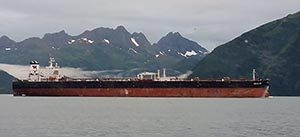Council observing process

Two foreign-flagged tankers hauled Alaska North Slope crude oil from the Valdez terminal this summer for the first time in over 30 years. The last time non-U.S. vessels shipped Alaska crude to foreign refineries was in the 1980s when West Coast refineries could not keep up with the amount of crude coming out of the pipeline.
The first tanker, the Tianlong Spirit, visited the terminal late last July and the second, the Cascade Spirit, arrived in early August. Both are chartered by BP, and owned by Teekay Corporation.
A ban on selling U.S. oil was put in place during the 1970s Arab oil embargo in an effort to keep Alaskan oil in the U.S. At the time, the U.S. was in the middle of an energy crisis and gasoline prices were soaring. Alaska oil was exempted from the ban in 1995 under President Clinton, although the oil still had to be transported by U.S.-flagged tankers. Congress lifted the export ban for the rest of the U.S. in late 2015, which the Alaska delegation sought for the past 20 years. This change also allowed foreign tankers to transport oil out of the U.S.
Both vessels are covered under BP’s oil spill contingency plan. Under U.S. regulations, BP is not permitted to ship oil domestically, and has chartered with Alaska Tanker Company, an American-owned corporation, since 1999. The Alaska Department of Environmental Conservation, or ADEC, approved BP’s request to add the Tianlong Spirit and Cascade Spirit to its oil spill contingency plan in July, which means these vessels can return to Prince William Sound in the future. The changes to the contingency plan did not require a public comment period.
Concerns arose when announcements were made about the tankers’ planned arrivals. The council’s executive director, Donna Schantz, had several conversations with Alyeska, BP, Coast Guard, and ADEC officials about the tankers’ compliance and the crew’s knowledge about Prince William Sound and the Alyeska terminal before the tankers arrived.
“Since the vessel crews had no prior experience working in Prince William Sound, we worked to verify that the captains and crews understood the systems in place for escorting, ice routing, communications, and other expectations specific to operating in our waters. Another major concern was that the vessels had the appropriate equipment for emergency towing specific to Prince William Sound. We have been assured that the crews were properly trained on Prince William Sound procedures, and that they had acceptable qualifications and equipment to meet all standards,” Schantz said.
“The United Nations’ International Maritime Organization sets the world’s standards for operation and safety of tankers,” said Alan Sorum, the council’s maritime operations manager. “U.S. standards are stricter than the international standards, plus Alaska has an additional requirement for a Prince William Sound towing package.”
Sorum explained that this towing package, which includes a buoy, chain, wire and line capable of towing a tanker in distress, is required by state law. The parts are all specially engineered according to the size of the vessel plus the high winds and seas often seen in Prince William Sound.
The Coast Guard the Alaska Department of Environmental Conservation performed inspections of both vessels. ADEC looked specifically at the Prince William Sound tow package and availability of oil spill response equipment on deck.
The availability of equipment and vessel crew qualifications have eased most of the concerns, but the council would still like to see these new tankers participate in a drill or towing exercise.
“That would ease concerns about lack of experience,” Sorum added.